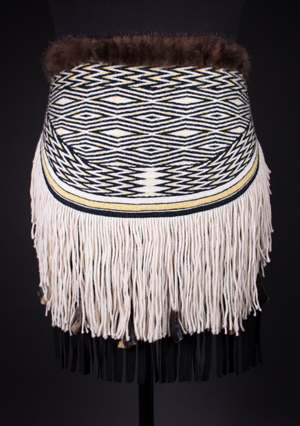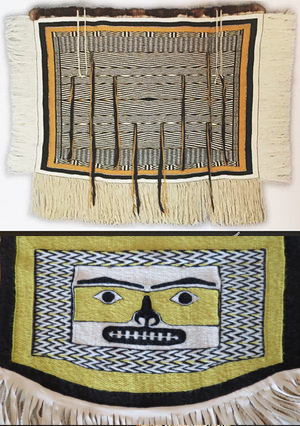Traditional HAIDA Weaving
I am from a long lineage of Haida weavers on my mother’s side. My mother, Evelyn Vanderhoop, is a master weaver of both the Naxiin and Raven’s Tail textile arts of the indigenous northwest. My Grandmother, Delores Churchill, is a renowned master weaver who has received numerous lifetime achievement awards, including the national endowment of the arts lifetime achievement award. I weave Raven’s Tail and Naxiin style Haida regalia. I started weaving Raven’s Tail with my sister when I was 22 years old. I continued to learn the different Haida textile weaving techniques from my mother, who also taught me the Naxiin style weaving, which depicts the formline art of the northwest cost. Before the task of weaving can begin the weaver has to prepare the materials to be woven. All the warp needs to be thigh spun in the traditional way, which is spun in the Z twist fashion. In the past mountain goat wool was used to spin the warp, in modern times we use merino wool roving. The warp is the foundation of the weaving itself and can only be created by an artist who is experienced in the Raven’s Tail or Naxiin style of weaving. To weave a full size chiefs robe you would need about 1,200 yards of warp. A full size Raven’s Tail Robe can take anywhere from 9 months to a year to complete and a full sized Naxiin robe can take up to three years to finish. One of my goals as a weaver is to complete several full sized Raven’s Tail robes. For me, creating these weavings is personally and culturally significant because it contributes to the cultural revitalization and decolonization of the Haida. These weavings serve as an unbroken link to my ancestors. The regalia that I create is worn by performers who dance, sing and drum at Potlatches and other Indigenous celebrations. A Potlatch is, to the Haida people, at the heart of the Haida political and economic systems. During a Potlatch an outpouring of wealth is displayed and given to the witnesses of the Potlatch. The Naxiin and Raven’s Tail woven chiefs robes were one of the most valuable possessions of the Haida people's, and were often cut to pieces and given to witnesses as a sign of wealth from the host of the Potlatch. In 1884 the Canadian government outlawed the Potlatch in an attempt to disassemble the strongly established society of the indigenous people of the northwest coast. Although disease wiped out a big portion of the Haida population and the Canadian government did its best to ethnically cleanse the indigenous people, we still remain and continue to grow and thrive and revitalize our traditions and culture by hosting Potlatches, raising Totem Poles, drumming, singing, speaking our language, and by creating our weavings, carvings and contemporary art.



